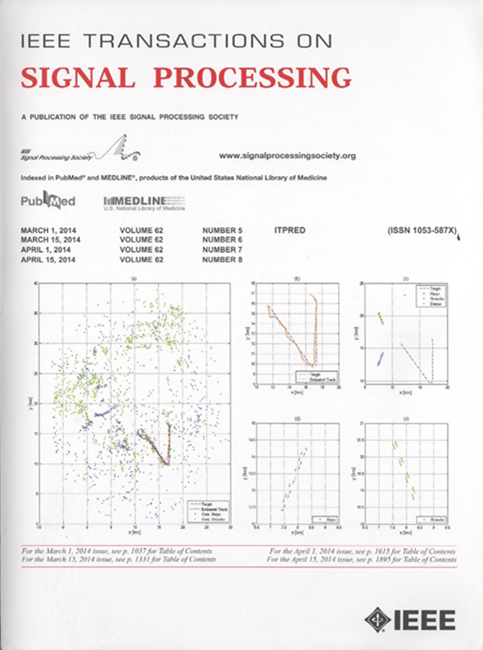Kronecker积协方差结构干扰下雷达探测的不变性理论第一部分:高斯环境
IF 4.6
2区 工程技术
Q1 ENGINEERING, ELECTRICAL & ELECTRONIC
引用次数: 0
摘要
本文分为两部分,讨论了嵌入在以未知Kronecker积结构协方差矩阵为特征的扰动中的距离扩展目标的最大不变检测。第一部分侧重于高斯干扰,而第二部分将研究扩展到复合高斯,杂波主导的环境。利用不变性原理,本部分确定了一个合适的变换组,该变换组有效地压缩了干扰参数空间,确保所有不变性检测器具有恒定的虚警率(CFAR)属性(相对于kronecker结构协方差矩阵)。推导出了极大不变量和诱导极大不变量,为指导CFAR探测器的设计提供了有力的工具。对于这种结构情况,现有的两步CFAR检测器被表示为所导出的最大不变量的函数。此外,设计了两种新的检测器(其CFARity在某些温和的技术条件下成立):前者采用伪缺失策略,将可能被目标信号污染的元素视为缺失,并利用期望最大化算法进行协方差矩阵估计;后者基于一步广义似然比检验准则,通过交替优化算法实现。最后,通过数值算例对该算法的CFAR行为和检测性能进行了评价,证明了该算法相对于传统决策规则的优越性。本文章由计算机程序翻译,如有差异,请以英文原文为准。
Invariance Theory for Radar Detection in Disturbance With Kronecker Product Covariance Structure—Part I: Gaussian Environment
This two-part paper addresses maximally invariant detection of range-spread targets embedded in disturbance characterized by an unknown Kronecker product-structured covariance matrix. Part I focuses on Gaussian interference, whereas Part II extends the study to compound-Gaussian, clutter-dominated environments. Leveraging the principle of invariance, this part identifies a suitable transformation group that effectively compresses the nuisance parameter space, ensuring the constant false alarm rate (CFAR) property (with respect to the Kronecker-structured covariance matrix) for all invariant detectors. A maximal invariant and an induced maximal invariant are subsequently derived, serving as powerful tools to guide the design of CFAR detectors. Some existing two-step CFAR detectors for this structured situation are expressed as functions of the derived maximal invariant. Furthermore, two novel detectors (whose CFARity holds true under some mild technical conditions) are devised: the former employs a pseudo-missing strategy by treating elements possibly contaminated by target signals as missing and utilizes an Expectation-Maximization algorithm to perform the covariance matrix estimation; the latter is based on the one-step generalized likelihood ratio test criterion and is implemented via an alternate optimization algorithm. Finally, their CFAR behavior and detection performance are assessed through numerical examples, demonstrating their superiority with respect to some conventional decision rules.
求助全文
通过发布文献求助,成功后即可免费获取论文全文。
去求助
来源期刊

IEEE Transactions on Signal Processing
工程技术-工程:电子与电气
CiteScore
11.20
自引率
9.30%
发文量
310
审稿时长
3.0 months
期刊介绍:
The IEEE Transactions on Signal Processing covers novel theory, algorithms, performance analyses and applications of techniques for the processing, understanding, learning, retrieval, mining, and extraction of information from signals. The term “signal” includes, among others, audio, video, speech, image, communication, geophysical, sonar, radar, medical and musical signals. Examples of topics of interest include, but are not limited to, information processing and the theory and application of filtering, coding, transmitting, estimating, detecting, analyzing, recognizing, synthesizing, recording, and reproducing signals.
 求助内容:
求助内容: 应助结果提醒方式:
应助结果提醒方式:


